This is a Kodak Flash Bantam, a strut folding camera with a Bakelite and metal body. The Flash Bantam updated the original Bantam 4.5 with flash synchronization and a new Lumenized lens coating to improve accuracy when using color film. It used 828 film which was originally designed to be an inexpensive roll film alternative to 135 format 35mm film, but without the two rows of sprocket holes. The lack of sprocket holes meant the exposed image produced a 28mm x 40mm negative that is 30% larger than that of 135 format film. The Flash Bantam was Kodak’s second from the top of the line 828 model, following the Bantam Special.
Film Type: 828 roll film
Lens: 48mm f/4.5 Kodak Anastar coated 4-elements
Focus: 2.5 feet to Infinity
Viewfinder: Flip Up Reverse Galilean Scale Focus Viewfinder
Shutter: Kodak Leaf
Speeds: T, B, 1/25 – 1/200
Exposure Meter: None
Battery: None
Flash Mount: Kodak Flasholder proprietary Post
Manual: http://www.cameramanuals.org/ko285dak_pdf/kodak_bantam_flash.pdf
History
In the early 20th century, photography was commonly done by large folding or box cameras. Cameras that used smaller formats like 127 were known as Vest Pocket cameras as they were the first that could easily fit into a coat (or vest’s) pocket.
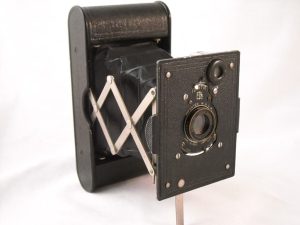
Despite these smaller film stocks, there wasn’t a true ‘miniature’ format available that would still look good when printed at larger sides, or had the ease of daylight loading capability. In an effort to shrink film stocks to be used in smaller cameras, many manufacturers like Goerz, Ernemann, and Ernst Leitz had the idea to adapt 35mm cinema film for use in a still film camera. Although the use of cinema film was growing in popularity, there wasn’t a consistent method in which to load and advance the film in the cameras designed for it. Many times, the 35mm film would travel vertically through the camera and require specialized film canisters that may or may not have required a dark room to load and unload.
In 1934, Kodak would attempt to solve this problem by releasing a new film standard called 135 format 35mm film which used a velvet lined metal cassette that would allow the film to be loaded into a camera in daylight. The film would travel horizontally through the camera and would be wound onto a takeup spool while shooting, and upon reaching the end of the roll, would be rewound back into the original cassette so it could be removed in daylight and sent in for developing.
135 format film turned out to be wildly popular and by the end of World War II became the most commonly used ‘miniature’ film format in the world. It would continue it’s popularity to this very day and is one of only two film formats still widely available.
While 135 format film was extremely popular, it wasted space on the film stock by having two rows of sprocket holes above and below the exposed image. These sprocket holes were designed for cinema cameras that needed to continuously move, but in a still camera, they weren’t actually necessary. These sprocket holes limited the size of an exposed image to 24mm x 36mm. Despite this ‘legacy’ inclusion of both rows of sprocket holes, the format was still highly successful.
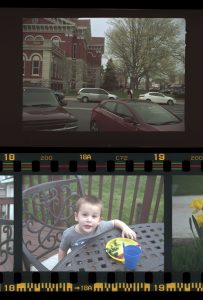
In 1935, Kodak made an attempt to popularize a variant of 35mm film without the sprocket holes which would allow for a larger 28mm x 40mm negative. This increased size allowed for a nearly 30% larger exposed negative which meant that photographs could be enlarged while retaining more detail. The new format was called 828 format film, and would be the same overall width as 135 format film but instead of two rows of sprocket holes, there would only be a single hole in between each frame on the film stock, so a camera would know when it had reached the next frame. 828 film was a paper backed roll film and did not come in a daylight loaded cassette. This likely was done to keep the costs low as Kodak probably didn’t want to eat into it’s own profits from their newly released 135 format.
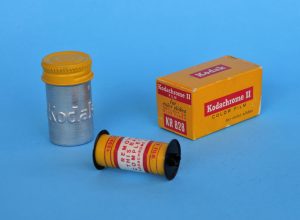
The first camera designed to use 828 film was a compact camera called the Kodak Bantam which had a body made entirely of Bakelite and came with a basic f/6.3 lens. Although the Bantam series was generally aimed at the low end of the market, there would eventually be a couple of higher spec 828 cameras like the Bantam Special and Bantam 4.5. Kodak was the primary maker of 828 film cameras, but there were 828 cameras made by other companies such as the Argus Model M and Photavit 828.
The Kodak Bantam was designed by industrial designer, Walter Dorwin Teague who had a long history designing cameras for Kodak and other companies. He helped create the unique lines of the Bantam series, along with the Kodak Jiffy, Brownie Special, and Medalist.
Almost all Bantam cameras were folding cameras held open by ‘scissor’ struts like the earlier Kodak Jiffy. The Kodak Special from 1936 was a high spec clamshell model that more closely resembled the design of a Kodak Retina, and the Bantam f/8 from 1938 had a solid bodied front lens that had a sliding box instead of a folding bellow system. Perhaps the most successful in the Bantam line was the Bantam 4.5 and Flash Bantam models from 1938 and 1947 respectively. Together, these two models accounted for a majority of the sales of Bantam cameras and 828 film.
Kodak would continue to produce 828 format cameras until the early 1960s, at which time the company would stop making new models. Despite no longer releasing any new models, it would continue to support the film standard until 1985.
During my research for this article, I could not find any conclusive evidence at how well 828 film sold. On one hand, it was made for nearly 50 years, but based on the lack of many models that supported it, I just don’t think that 828 really caught on that well. Aside from the Bantam Special which was only available for a very short period of time, there were no other medium to high spec cameras that used the format.
Today, Kodak Bantams have a small, but loyal following among people who appreciate their uniqueness. The increased image size gives a bit more detail than a standard 35mm image which partially bridges the gap between 35mm miniature film, and medium format images. While 828 film is a pretty obscure format to find today, some 828 enthusiasts roll regular 135 format film into 828 spools and shoot with it. Shooting 135 film in a 828 camera means that the sprocket holes will be visible in the exposed images, but for most people, this is rarely a deal breaker. More ambitious fans of 828 film will cut down 120 roll film to the same size as 828 film and use that instead.
Perhaps the world’s authority on 828 film, Adam Paul has an entire article explaining how he cuts down 828 film using 120 film and a custom rig he made using a TLR and some razor blades. Click this link to read the entire article yourself if this is something you’d like to try.
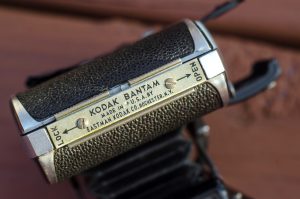
My Thoughts
My first experience with an 828 film camera was the original Bantam f/6.3 which I picked up in the fall of 2015. Due to some unfortunate circumstances, my first roll through it was a bust and I just never got around to shooting it again. Then, on a lazy Saturday in the fall of 2016, my wife suggested we go to a few garage sales and there on a table of junk was a $3 Kodak Pony 828. I was aware that the Kodak Pony was Kodak’s inexpensive lineup of basic 35mm cameras in the 1950s, but there was a little known variant that used 828 film and sensing an opportunity to try an often overlooked model (plus, I am incapable of passing up any camera for $3), I picked it up.
Around Christmas of 2016, my friend Adam, suggested I try out the Kodak Flash Bantam with the f/4.5 Anastar lens. The Anastar is a 4-element design that is identical to Kodak’s earlier Anastigmat Special, a lens which is on the Kodak 35 which I have previously reviewed to very high acclaim.
Adam wrote an excellent and very personal review of his own Kodak Bantam 4.5 that had previously belonged to his father. Adam found some old slides taken by his father with his own Bantam, and attempted to recreate them using the very same camera that took the originals. It should come as no surprise that his story motivated me to want to try 828 film and it was with a surprise this past Christmas that a “mystery” box from Adam appeared that contained a variety of films for me to try out, an extra M42 lens he had picked up for nothing, and this little Kodak Flash Bantam.
The Flash Bantam replaced the Bantam 4.5 in 1947 and is nearly identical to the original Kodak Bantam 4.5 with the exception that it has a proprietary flash sync port, a rebranded “Anastar” lens, and an updated “Lumenized” coating. Knowing my previous poor luck with 828 film, Adam even went the extra mile and pre-loaded the camera with a roll of Kodak Portra 160 that he had cut down to 828 size. An advantage of using cut down film is that you can squeeze more exposures out of a single roll than an original roll of 828 would have had. Adam’s roll allowed me to get 15 exposures, whereas an original roll would have only allowed for 8.
Knowing that I had been given a perfect opportunity to see what these little cameras could do, I decided that I didn’t want to shoot the camera until the temperatures warmed and I could get outside and shoot more color. When I did however, the size and compactness of the Bantam immediately impressed me. Unlike the original Kodak Bantam 6.3 which has an entirely Bakelite body, the Bantam 4.5 has a more traditional metal and Bakelite body. It weighs a tad more, but in terms of size, when folded shut is still quite compact. The Bantam is about as wide as an early Kodak Retina, but is both shorter and thinner.
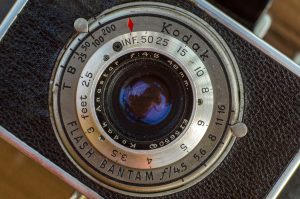
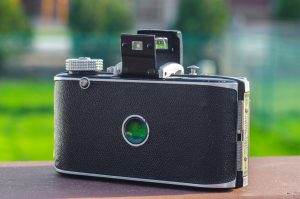
Combined with the smaller body, the Bantam 4.5 also has a flip up “reverse Galilean” viewfinder which is something I’ve commented about in other articles as I am very fond of their size, and ease of use. On paper, it might seem that the primitive flip up finder isn’t very good, but in use it offers a larger and brighter view compared to the tiny solid viewfinders found on other 1940s and early 1950s cameras. Plus, by moving the rear glass frame forward or backward, you achieve a primitive “adjustable diopter” effect which is super useful for people like me who use prescription glasses. Part of the reason I love the original Kodak 35 was for it’s implementation of this very same feature.
Also like the Kodak 35, the Flash Bantam / Bantam 4.5 has a full selection of shutter speeds and apertures from 1/25 – 1/200 plus T and B, and f/4.5 – f/16. The front focusing lens can get as close as 2.5 feet and from there goes to infinity. Although making any adjustment to the Bantam requires the camera to be lowered from your eye, I appreciated the fact that all 3 settings are all accessible at once, from the front of the lens. If you take advantage of consistent lighting and use zone focusing, you can fire off several shots back to back with the Bantam very quickly.
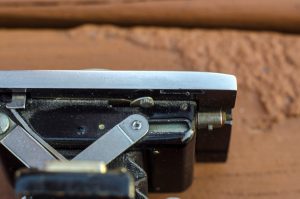
The shutter release is conveniently located on the top plate of the camera and falls almost exactly where my finger would have rested normally even if it hadn’t been there. I found that with the large and bright viewfinder, the top shutter release, and the ease of changing settings on the lens, that the ergonomics of the little Bantam were better than those of many cameras of the era, with one exception. That is the shutter cocking lever. Once you know it’s there, it’s not too bad to use, but it is somewhat hidden near the top right strut hinge behind the front shutter plate. It takes a moment to locate the first time you use the camera, but on the bright side, once you know it’s there, it is easy to see if the shutter is cocked or not. Expecting perfect ergonomics of every control on a very compact folding camera from the 1940s is a tall ask, and to the Bantam’s credit, it didn’t slow me down while shooting so this is just a minor nitpick.
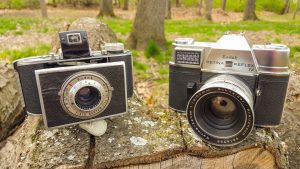
I shot most of the roll with the Kodak Flash Bantam at the exact same time as the Kodak Retina Reflex IV, which is a leaf shutter 35mm SLR made by Kodak in the early 1960s. Despite both bearing Kodak names, the two cameras couldn’t be any more different. Although I ended up getting very good images from the Retina Reflex, the shooting experience was quite miserable. I found myself eagerly picking up the Bantam to fire off a few shots while I often felt like I was forcing myself to finish the roll in the Retina Reflex.
Although the Bantam lacks a rangefinder, the 48mm focal length of the lens maximizes depth of field, making zone focusing in well lit conditions extremely easy. The exposed image on 828 film is 30% larger than 35mm which means the 48mm focal length is comparable to a semi-wide angle 37mm focal length on normal 35mm film. According to the depth of field chart in the Bantam manual, at f/11 and set to a distance of 8′ away, everything from 5′ to 21’6″ will be in focus. At 15′ away, everything from 7′ to infinity will be in focus. This makes the Bantam function similarly to a fixed focus camera outdoors. Set the aperture to f/16 and you get even more range.
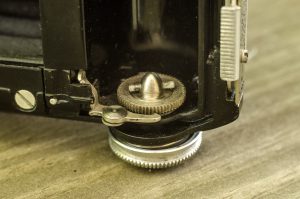
A word of caution for those trying to use an 828 camera with “cut down” film like the one Adam gave me, is that genuine 828 film has a single hole for every exposure on the film that is designed to trip a “feeler” inside of the film compartment that prevents you from advancing the film beyond one frame. This feature of 828 film allows you to advance the film without having to look at the orange (or green) window on the back of the camera. When you cut a larger film stock like 120 down to 828 size, this hole will not be present, which defeats this ability, so you must pay attention to the exposure numbers on the backing paper. It is also advisable when shooting a faster film like Portra 160 that you protect the rear window from direct sunlight. A small square of electrical tape over the window that can be peeled back while advancing the film is a good idea.
I mention in my review for the original Kodak Bantam 6.3 that my biggest regret for the Bantam is that 828 film didn’t catch on more. While I understand that any roll film format is going to be more difficult to load than a daylight loading cassette like in 35mm film, the increased exposed image size and the smaller size of the spool makes for a really capable miniature camera. A 30% increase in size might not seem like much, but when printing, a 5×7 would have the detail of an 8×10, and an 8×10 would have the detail of an 11×14 and so on.
I thoroughly enjoyed my time with the Bantam and went through that first roll all too quick. I enjoyed it’s compact size, easy to use flip up viewfinder, and mostly excellent ergonomics. The Kodak Anastar lens is already regarded as a very capable lens, so assuming I would get some nice shots out of it, this would be a camera that will be calling to me again in the future. I don’t have the emotional attachment to the Bantam or 828 like Adam did with his father, but when it comes to a really great and compact camera, I have to agree with his fondness for it!
My Results
I received the Flash Bantam in the middle of winter and was eager to get out and shoot it so I threw it in a bag of other cameras I was working on at the time. After taking my first shot, I realized this was a camera that demanded more attention and shouldn’t be rushed. I took one winter shot and then shelved the camera until spring, when I could dedicate more time to it.
The shots below represent the best of what I got out of the 15 exposures from Adam’s test roll of cut down Portra 120 to 828 size.
These images represent a mish-mash of some good and bad. The good news is that I can’t blame the camera for any of the “bad”. Sadly, of the 15 or so shots I should have gotten from this camera about 6 of them were completely washed out. It’s plausible that light exposed the film during the cutting, loading, unloading, or even by the lab. This film was sent to Willow Photo Lab in Willow Springs, MO who has given me inconsistent results in the past, so there is a very good chance that the images were ruined at the lab but there is no way to know for sure.
In any case, what I did get from the remaining shots was impressive. I should also confess that I scanned these negatives myself on an Epson V550 flatbed scanner using the Epson’s regular 35mm film holder. Since 828 is the same physical width as 35mm, the film fit correctly, but since the film holder is designed to cover up the sprocket holes which are missing on 828, part of the exposed image was cropped off during scanning. All of the images above have a subtle panoramic effect with the extreme tops and bottoms missing. In none of the images did this negatively affect the composition, but it’s worth mentioning.
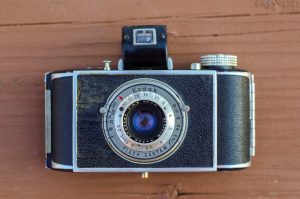
You can see a few light leaks which could be from a tiny leak in the bellows, and in one image, I double exposed two shots, but otherwise what is there is impressively sharp. Despite having an image size only slightly larger than 35mm, if you click on each image and view them full screen in your browser, there is an incredible amount of detail. I’d even go as far as to say that these have a slight medium format look to them on my computer monitor. The 4-element Kodak Anastar lens is every bit as good as I had hoped. I fell in love with this lens on my Kodak 35, and it excelled quite nicely here. I do not know the lens formula used in this lens, but I’d say it compares very favorably to the 4-element Zeiss Tessar.
Sharpness is very good and even across the frame, color accuracy is spot on for what I typically see with Portra, and I only see a very tiny hint of vignetting at the corners, which is on par with other 4-element lenses of the era. It is clear that the Kodak Flash Bantam was more than just an inexpensive point and shoot. Had 828 film caught on more, it is likely this camera would have continued to evolve into a very respectable medium-priced camera.
The Bantam 4.5 and Flash Bantam represent the runner up to the top of the line 828 camera, which was the Bantam Special. An elegantly designed camera that frequently demands obscene prices on the used market. It is not unusual for a nice looking Bantam Special to fetch upwards of $300, whereas these “lesser” Bantams can sometimes go unsold for $10. The huge price disparity has absolutely nothing to do with the quality of images it is capable of. The Flash Bantam and it’s f/4.5 Kodak Anastar lens do an excellent job of showing off what the 828 format was capable of. If you are in the market for a compact and fun little camera with a good lens, and are ambitious enough to either roll in regular 35mm film or try and cut down your own 828 film, I highly recommend giving one a try!
My Final WordHow these ratings work |
The Flash Bantam / Bantam 4.5 is a very good and compact folding camera that uses 828 film and has an excellent f/4.5 Kodak Anastar lens. Although getting viable 828 film can be difficult today, if you go through the effort to locate and roll, you’ll be rewarded with some surprisingly excellent images that are 30% larger than normal 135 format 35mm film. When folded, the camera is very compact and fits nice in a pocket. The Bakelite and metal body is very well built, and unlike most non-Retina folding Kodak cameras, the bellows on these are usually in good order. | ||||||
| Images | Handling | Features | Viewfinder | Feel & Beauty | History | Age | |
| 2 | 2 | 1 | 1 | 1 | 0 | 30% | |
| Bonus | none | ||||||
| Final Score | 9.1 | ||||||
Additional Resources
http://camerapedia.wikia.com/wiki/Kodak_Bantam
http://camera-wiki.org/wiki/Kodak_Bantam
http://kodak.3106.net/index.php?p=209&cam=1286
http://photo.net/classic-cameras-forum/00ZVEq
http://quirkyguywithacamera.blogspot.com/search/label/828%20Film

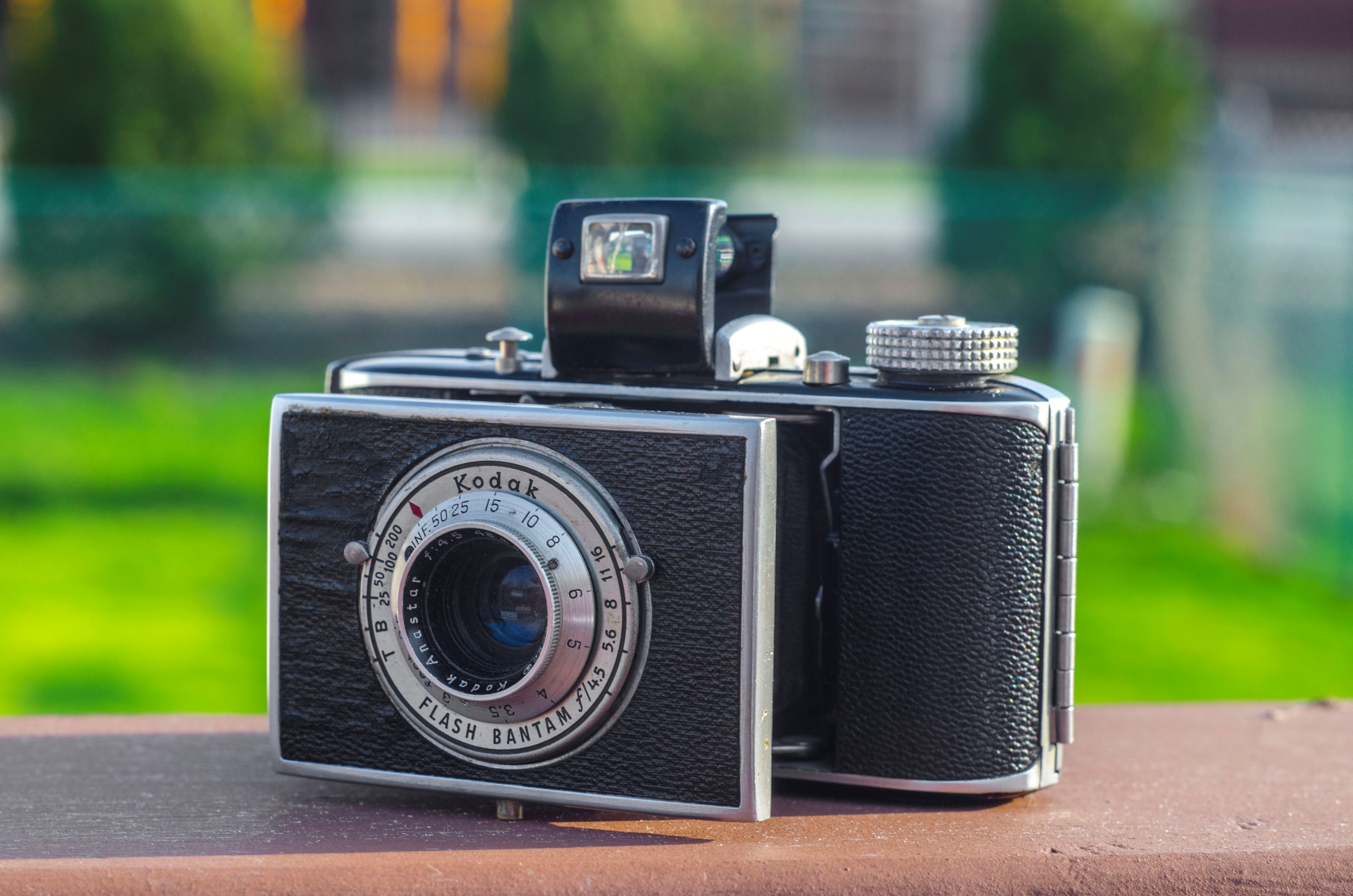
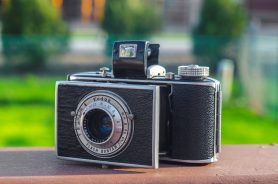
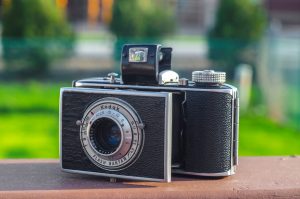








Hey Mike. I think I’m picking up a Bantam on Tuesday and wonder if you think the sprocket feeler mechanism could be modified to find the sprocket holes but not stop the film winding? I’m imagining counting clicks as each hole in my 35mm film finds the feeler, as a foolproof way to get accurate and consistent frame spacing.
Randy, I am sure anything’s possible, but I would have no idea how to do that. I’ve shot perforated 35mm film in an 828 camera before, and there’s two ways to do it without modifying the camera. If you can find real 828 backing paper, and then tape a strip of 35mm film to the paper in the same location that the original 828 would be, the feeler will skip over the perforations in the 35mm film where the hole isn’t in the backing paper. When you get to the hole in the paper, the feeler should be able to detect it through the perforations in the film.
A second method is to just use regular 35mm without any backing paper. You’ll need to cover up the green or yellow window in the door with tape though, and just count how many turns of the dial you use to properly advance the film. This is mostly trial and error, and will definitely waste film in between exposures though as it’s better to err on the side of winding too much than too little.
Beyond that though, I don’t know how to modify the cameras to do what you describe. If you figure it out though, please share it so I can tell other people too!